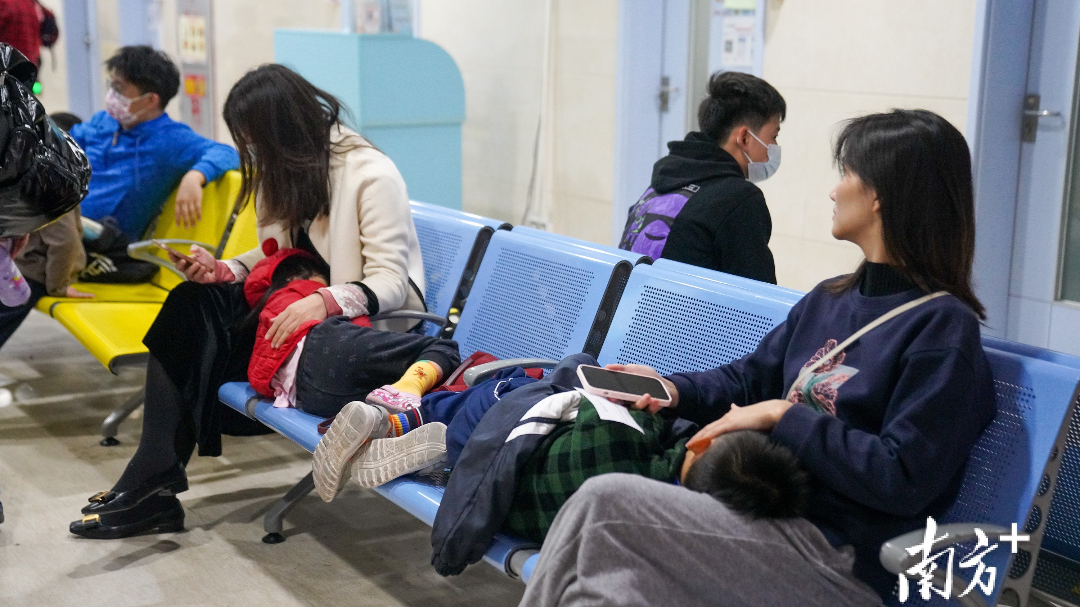Acute respiratory infectious diseases, mainly influenza and mycoplasma pneumoniae, are currently relatively active in Guangzhou. Respiratory infections caused by a variety of common respiratory pathogens such as rhinovirus, adenovirus, and respiratory syncytial virus are intertwined, according to the Guangzhou Center for Disease Control and Prevention.

(Photo: Nanfang plus)
What needs special attention is that the influenza activity has increased significantly. At the same time, influenza A H3N2 subtype and Victoria B influenza virus are circulating. Influenza is gradually entering the winter epidemic period.
Influenza, mycoplasma pneumoniae, and respiratory syncytial virus (RSV) infections all cause symptoms such as cough and fever. How do you tell the difference?
1. Influenza
Influenza is an acute respiratory infectious disease caused by influenza viruses. Influenza patients and latent infections are the main sources of infection. The main route of transmission is droplet transmission. It can also be transmitted through direct or indirect contact with mucous membranes such as the mouth, nose, and eyes.
Influenza has an incubation period of 1-4 days, with acute onset, mainly characterized by fever (some cases can have a high fever, up to 39-40℃), cough, sore throat, headache, myalgia and general malaise. There may be symptoms including chills, muscle and joint pains, fatigue and loss of appetite. Some patients may be accompanied by vomiting, abdominal pains and diarrhea, mostly in children.
Influenza patients generally have a good prognosis. The high fever gradually subsides, and systemic symptoms improve in 3-4 days after the onset of illness. However, children, the elderly, people with underlying diseases, obese people, and pregnant women are more likely to develop severe symptoms after infection and should seek medical treatment in time.
Influenza vaccination can effectively reduce infection, and it can also lower the risk of having a serious illness.
2. Mycoplasma pneumoniae
Mycoplasma pneumoniae is mainly spread through droplets and direct contact, and the population is generally susceptible. It mostly occurs in children over 5 years old and adolescents. Usually, when seasons change, such as when summer turns to autumn or autumn turns to winter, localized and short-lived cluster epidemics may occur.
The incubation period is 2-3 weeks. Once infected, the main symptoms are similar to those of most respiratory diseases, with fever and cough being the main ones. Generally, the cough is severe. After the fever subsides, the cough may continue for 1 to 2 weeks. After children are infected with mycoplasma, most of them exhibit symptoms of? upper respiratory tract infection. A small number of them have a lower respiratory tract infection (possibly bronchitis or pneumonia), and a very small number may develop severe mycoplasma pneumonia.
In general, infections of mycoplasma pneumoniae won't recur in the short term (1-2 months). It should be noted that if the symptoms of infection recur, it is often because the last mycoplasma pneumoniae infection has not been cured and the local lesions have not been completely cleared, leading to secondary infection.
Currently, there is no vaccine to prevent mycoplasma pneumoniae infection. Therefore, if there is a fever accompanied by a severe cough, it's advised to consult a doctor as soon as possible to identify the cause of the disease and receive standardized treatment. Do not blindly use medicines on your own.
3. RSV
RSV is a common, highly contagious RNA virus spread through droplets and close contact, or through contaminated hands and surfaces.
The incubation period is usually 2-8 days. After being infected, patients tend to have upper respiratory tract symptoms. Typically, children suffer from fever, cough, nasal congestion and runny nose, while adults suffer from low-grade fever, cough, nasal congestion and runny nose, which are similar to those after getting a cold.
Most patients' symptoms will disappear on their own within 1-2 weeks. A small proportion can develop lower respiratory tract infections (i.e., capillary bronchitis or pneumonia), which are most common in infants and young children, with clinical symptoms including coughing and wheezing.
It can be infected repeatedly and is easily transmitted in families. So infection can be prevented by measures such as strengthening personal protection.
4. Rhinovirus
Rhinovirus is one of the main pathogens causing the common cold. It spreads mainly through direct contact and droplets. Infants, the elderly, and immunocompromised people are susceptible to rhinovirus.
After being infected with rhinovirus, there will be an incubation period of 2-5 days. The main clinical manifestations are runny nose, sneezing, pharyngeal discomfort, nasal congestion, cough, mild sore throat, and no or slightly increased body temperature, often accompanied by nasosinusitis and tympanitis. Although immunity can be acquired after rhinovirus infection, the duration is short-lived, so people can be infected with rhinovirus repeatedly.
There are currently no specific prevention and treatment methods. Patients' conditions are usually self-limiting, with mild symptoms that heal up in about a week.
5. Adenovirus
Adenovirus is a common virus that causes respiratory tract infections and is the main cause of community-acquired pneumonia in children. It can be transmitted through droplets, close contact and fecal-oral routes, and can also be transmitted through water bodies. Infants over 6 months old, school-age children, and people with low immune function are high-risk groups for adenovirus infection.
The course of the disease is usually 5-7 days, but symptoms may last up to 2 weeks and may be complicated by bacterial infection. Symptoms vary depending on the area affected and can include fever, sore throat, runny nose, cough, earache, conjunctivitis, diarrhea, and hoarseness.
Most adenovirus infections are self-limiting and are treated with supportive treatment. Antiviral therapy is usually used only for severe adenovirus infections, and most of these patients have impaired immune function.
The main way to prevent adenovirus infection is to pay attention to hygiene, especially hand hygiene.
In addition, Guangzhou CDC reminds residents that once infected with infectious diseases in winter and spring, patients should be hospitalized or rest at home according to their conditions and doctor's recommendations. During this period, they should avoid participating in group activities and entering public places, and resume daily activities such as going to school and work after being non-infectious.
Author | Hannah, He Yanting (intern)
Editor | Oivia, Nan, Jasmine, James
















